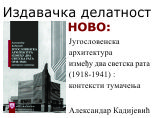Arheologija
|
Курс:
Династички Египат: свети и световни простори (мастер) У оквиру предмета: Династички Египат: свети и световни простори
Предавачи:
Не постоје подаци о траженом предавачу. Број бодова: 6.00 изборни предмет Садржај предмета: Преглед кључних питања организације египатског друштва (укључујући ниво породице), погледа на свет, схватања исправног понашања, те економије чини уводни део курса. У жижи курса је испитивање како и у коликој мери су религија и свети простори интегрисани у свакодневни живот. На одабраним примерима насеља, некропола и храмова ће бити анализиран начин на који су обликовани ти простори, како су коришћени и у каквом су односу међусобно и спрам природног окружења, а са посебним освртом на промене у схватању и употреби неког простора. Начин на који се реконструише слика друштвене и економске праксе ће бити преиспитиван кроз анализу различитих врста примарних извора и изабраних публикованих интерпретација. Циљ изучавања предмета: Дубоко разумевање међусобног прожимања наших категорија светог и световног у култури Египта; развијање самосталног просуђивања о различитим аспектима друштвених односа и понашања у династичком Египту.
Предуслови за полагање: солидно познавање енглеског језика Облици наставе: предавања, семинари, дискусија, презентацијe самостално израђених есеја (до 3000 речи)
|
Литература и извори података: ***
Општа обавезна литература
AUFRÈRE, S.H. 2001. The Egyptian temple, substitute for the mineral universe. In Colour and Painting in Ancient Egypt, ed. by W.V. Davies, 158-163. London: British Museum.
BAINES, J. 1990. Restricted Knowledge, Hierarchy, and Decorum: Modern Perceptions and Ancient Institutions. Journal of the American Research Center in Egypt 28: 1-23.
BAINES, J. 1997. Temples as symbols, guarantors, and participants in Egyptian civilization. In The Temple in Ancient Egypt, ed. by S. Quirke, 216-241. London: British Museum.
BLOXAM, E. and T. HELDAL. 2007. The Industrial Landscape of the Northern Faiyum Desert as a World Heritage Site. World Archaeology 39(3): 305-323.
DORMAN, P.F. and B.M. BRYAN (eds.). 2007. Sacred Space and Sacred Function in Ancient Thebes, SAOC 61. Chicago: The Oriental Institute.
JEFFREYS, D., and A. TAVARES. 1994. The Historic Landscape of Early Dynastic Memphis, Mitteilungen des Deutschen Archäologischen Instituts Kairo 50: 143-173.
JEEFREYS, D. 2010. Regionality, Cultural and Cultic Landscapes. In Egyptian Archaeology, ed. by W. Wendrich, 102-118. Oxford: Willey-Blackwell.
LAZARIDIS, N. 2008. Ethics. in: UCLA Encyclopedia of Egyptology, ed. by E. Frood and W. Wendrich. Los Angeles. http://repositories.cdlib.org/nelc/uee/1021
LOVE, S. 2006. Stones, ancestors, and pyramids: investigating the pre-pyramid landscape of Memphis. In The Old Kingdom Art and Archaeology. Proceedings of the Conference, ed. by M. Barta, pp. 209-218. Prague: Czech Institute of Egyptology.
MAGLI, G. 2011. From Abydos to the Valley of the Kings and Amarna: the conception of royal funerary landscapes in the New Kingdom. Mediterranean Archaeology and Archaeometry 11(2): 23-36. (2011). http://www.maajournal.com/
MESKELL, L. 1998. An Archaeology of Social Relations in an Egyptian Village. Journal of Archaeological Method and Theory 5(3): 209-243.
O’CONNOR, D. 2009. Abydos. Egypt’s First Pharaohs and the Cult of Osiris. London: Thames & Hudson.
RICHARDS, J., Society and Death in Ancient Egypt. Mortuary Landscapes of the Middle Kingdom, Cambridge 2005.
Општа допунска литература
BAINES, J. and P. LACOVARA. 2002. Burial and the dead in ancient Egyptian society. Respect, formalism, neglect. Journal of Social Archaeology 2(1): 5-36.
BIERBRIER, M. 1989. The Tomb-Builders of the Pharaohs. Cairo: AUC Press.
GILLAM, R. 2005. Performance and Drama in Ancient Egypt. London: Duckworth.
MCDOWELL, A. G. 2001. Village Life in Ancient Egypt. Laundry Lists and Love Songs, Oxford: OUP.
LESKO, L.H. (Ed.).1994. Pharaoh’s Workers. The Villagers of Deir el Medina. Ithaca: Cornell University Press.
TRIGGER, B.G. 1993. Early Civilizations. Ancient Egypt in Context. Cairo: AUC Press.






